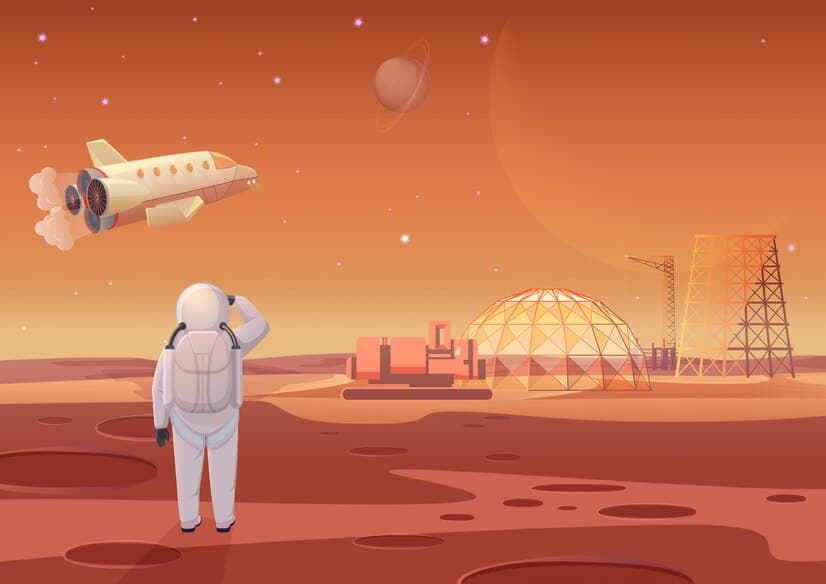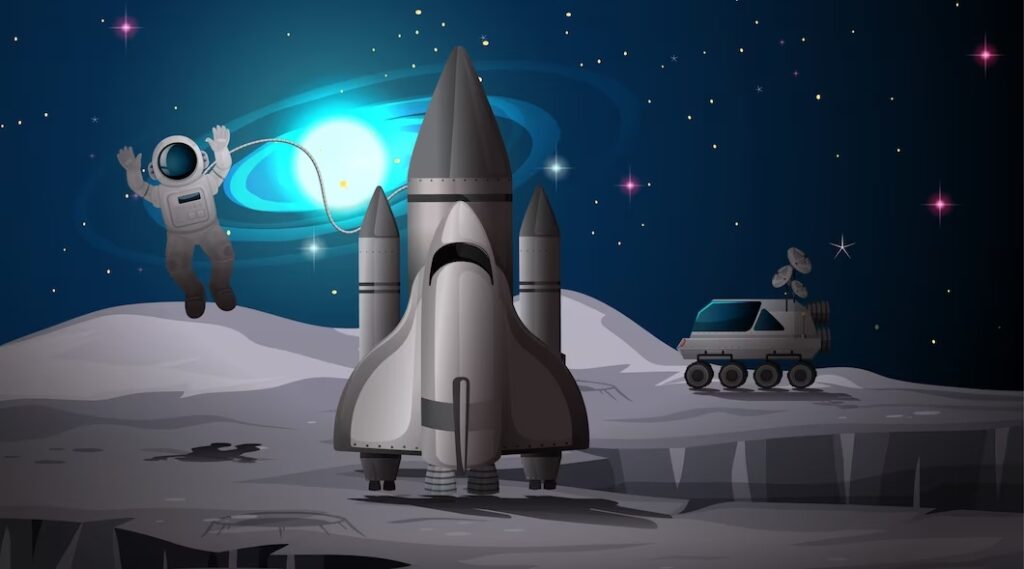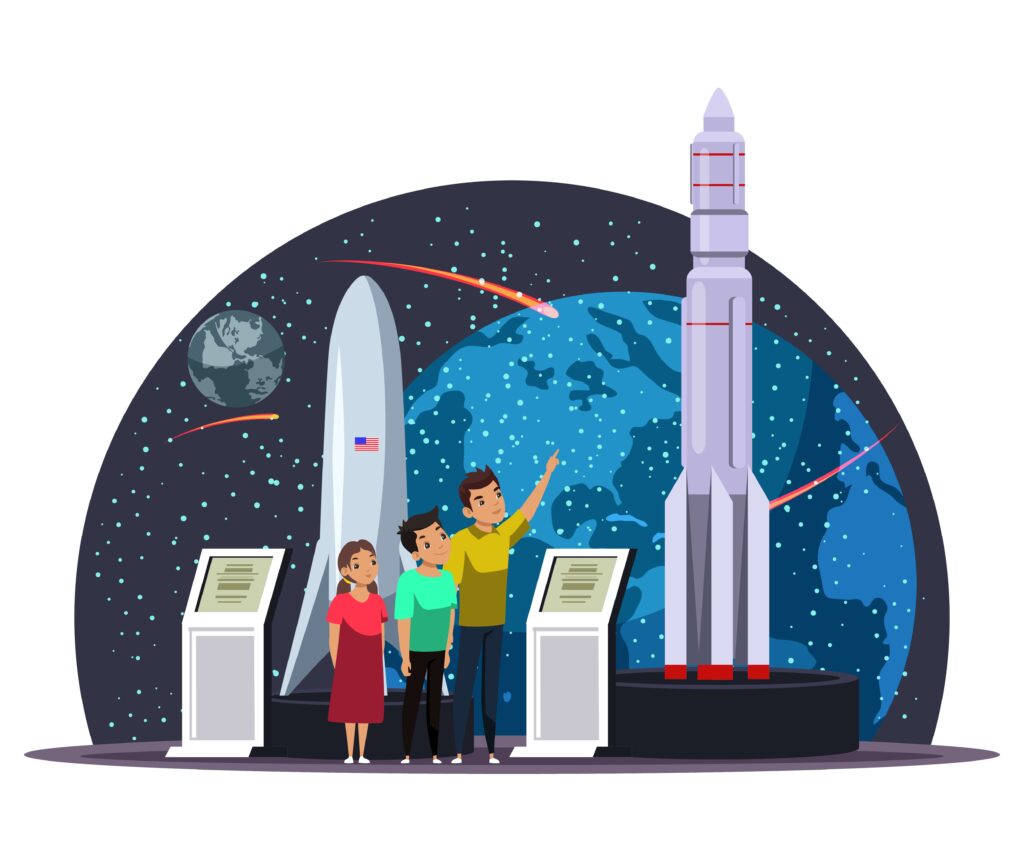Space tourism has long been a dream for many, and recent technological advancements have brought this ambitious aspiration closer to reality. Skyrocketing beyond mere science fiction, the emerging market of space tourism has captured the imagination of entrepreneurs and enthusiasts alike.
With the potential for commercial space travel becoming increasingly tangible, the opportunity to explore the cosmos, witnessing Earth from a breathtaking vantage point, will soon be within the reach of ordinary people.
A handful of pioneering companies have ventured into the development of space tourism infrastructure, setting the stage for a new era of exploration and adventure. The industry’s flagship enterprises range from ambitious startups to well-established corporations, all working tirelessly to establish themselves as leaders in an emerging market, fueled by dreams of zero-gravity excursions and lunar vacations.
As we stand at the dawn of a new space age, it’s essential to understand the challenges and opportunities space tourism presents. While the industry is fraught with uncertainties, the promise of making what was once a privilege reserved for astronauts accessible to the general public is driving tremendous innovation. Consequently, space tourism is poised to catalyze an unprecedented era of human achievement and exploration.
Table of Contents
Definition of Space Tourism
Space tourism refers to the commercial activity in which private individuals can purchase tickets to travel to space for recreational, leisure, or experiential purposes. Unlike traditional space missions primarily focused on research and development, military operations, or telecommunications, space tourism aims to make space travel accessible to people who are not professional astronauts.
This form of tourism usually involves suborbital, orbital, or lunar trips and may include activities like weightless experiences, Earth observation, and potentially even stays at space hotels or stations.
History of Space Tourism

Space tourism has its roots in the early days of human spaceflight. Alan Shepard, the first American in space, took a brief 15-minute suborbital flight in 1961, but it wasn’t until much later that the concept of space travel for ordinary citizens began to take shape.
In 2001, American businessman Dennis Tito became the first private space tourist when he paid $20 million for a trip to the International Space Station (ISS) aboard a Russian Soyuz spacecraft. Tito’s groundbreaking voyage blazed the trail for others to follow. In the following years, a handful of private individuals, including South African entrepreneur Mark Shuttleworth and American businessman Gregory Olsen, followed in Tito’s footsteps, embarking on their space adventures.
The idea of space tourism continued to develop as private companies, such as MirCorp, began making plans for commercial space travel. MirCorp, a now-defunct company, was created to establish a commercial space station called Mir-2, derived from the Russian space station Mir that operated in low Earth orbit from 1986 to 2001.
The Ansari X-Prize, a competition offering a $10 million prize to the first non-government organization to launch a reusable crewed spacecraft twice within two weeks, played a significant role in the development of the industry. In 2004, SpaceShipOne, designed by Burt Rutan and financed by Microsoft co-founder Paul Allen, claimed the prize and put space tourism on the map.
Over the years, several high-profile space tourists embarked on their own journeys to space, including Northrop Grumman Corporation researcher Anousheh Ansari, who became the first Iranian and female space tourist in 2006. Microsoft software architect Charles Simonyi visited the ISS twice (in 2007 and 2009), while Richard Garriott, a computer game developer, travelled to space in 2008. Cirque du Soleil Founder Guy Laliberté journeyed there in 2009.
Space tourism continues to evolve today, with private companies such as SpaceX, Blue Origin, and Virgin Galactic developing reusable spacecraft to make space travel more affordable and accessible to the public. While the industry is still in its infancy, the history of space tourism demonstrates that the dream of space travel is becoming a reality for people from all walks of life.
Major Players in Space Tourism
SpaceX
SpaceX, founded by Elon Musk in 2002, is a leader in the space tourism industry. It focuses on reusable rocket technology, allowing more affordable and accessible space travel. SpaceX has successfully launched and landed the Falcon 9 and Falcon Heavy rockets multiple times, significantly reducing costs. One of the company’s most ambitious projects is Starship, a fully reusable spacecraft designed for long-duration missions and carrying large crews. SpaceX has plans to take private passengers on lunar trips around the Moon, with the first mission tentatively scheduled for 2023.
Blue Origin
Blue Origin, led by Amazon founder Jeff Bezos, is another crucial player in the space tourism market. Founded in 2000, the company aims to make space travel more accessible through reusable rocket technology. Its flagship vehicle, the New Shepard, is designed for suborbital flights, offering passengers a few minutes of weightlessness and views of Earth from space. Blue Origin has completed multiple test flights and plans to begin commercial operations shortly.
Virgin Galactic
Virgin Galactic, founded by Sir Richard Branson in 2004, is focused on creating a world-class space tourism experience. With its unique air-launched spacecraft, SpaceShipTwo, the company aims to offer suborbital flights for passengers, providing several minutes of weightlessness and impressive views of Earth.
Virgin Galactic has completed multiple successful test flights and plans to begin commercial operations soon. More than 600 people have already secured tickets for the first flights, with prices starting at $250,000 per seat.
Although NASA is not explicitly involved in private space tourism, the agency has worked with SpaceX and other companies to support the development of commercial space travel. For example, NASA’s Commercial Crew Program has facilitated the growth of a competitive market for crew transportation to and from low-Earth orbit, serving both government and private-sector customers.
Types of Space Tourism

Suborbital
Suborbital space tourism focuses on taking passengers to the edge of space, providing them with a view of Earth from above and a taste of weightlessness. In these missions, spacecraft reach altitudes between 80 to 100 kilometres before returning to Earth. Suborbital flights last a few minutes and are designed to provide a thrilling and unique experience rather than extended travel to different destinations in space. Several private companies, such as Blue Origin and Virgin Galactic, are developing spacecraft for suborbital tourism.
- Blue Origin’s New Shepard: This reusable rocket system can carry up to six passengers and reaches altitudes just above the Karman line, providing a few minutes of weightlessness.
- Virgin Galactic’s SpaceShipTwo: This air-launched spacecraft also offers passengers a brief experience of weightlessness and a view of Earth from space, with potential for future improvements and modifications.
Orbital
Orbital space tourism takes passengers to low Earth orbit (LEO) aboard a spacecraft that orbits our planet. These more ambitious missions allow tourists to experience life aboard a space station, observe Earth from a unique perspective, and potentially engage in scientific research. Orbital space tourism has a higher level of complexity when compared to suborbital missions, and there have been fewer orbital tourist flights to date. The Russian space agency, Roscosmos, has previously facilitated orbital space tourism missions.
International Space Station (ISS) visits: Since 2001, a select number of tourists have travelled to the ISS with the assistance of Roscosmos. These orbital missions typically last around ten days, with tourists participating in activities such as spacewalks and observing Earth from the station.
While lunar space tourism, which would involve a journey to the Moon, is not yet available, it represents a potential future development in the industry. Private space companies like SpaceX have announced plans to eventually offer lunar space tourism missions, though specific timelines and details have yet to be confirmed.
Advantages and Disadvantages of Space Tourism
Space tourism is an exciting and evolving field that offers a range of potential benefits and challenges. Here’s a look at some of the advantages and disadvantages:
Advantages
- Economic Growth: The space tourism industry could become a significant revenue generator, creating jobs and stimulating investment in related sectors like aerospace engineering, hospitality, and training services.
- Technological Advancements: Commercial investment in space tourism can spur technological innovation as companies compete to offer safer, more efficient, and more affordable space travel.
- Public Engagement: The prospect of space tourism can increase public interest and engagement in space exploration and science, potentially inspiring a new generation of scientists, engineers, and ordinary people to look to the stars.
- Global Collaboration: The space tourism industry could foster international cooperation as countries and private enterprises collaborate on regulatory frameworks, safety protocols, and best practices.
- Democratization of Space: Although still expensive, the growth of space tourism could eventually make space more accessible to people other than highly trained astronauts and the military, democratizing the experience of space travel.
- Educational Value: Direct experiences of space travel could offer immense educational value, enhancing our understanding of human physiology in space and giving people a unique perspective on Earth that could promote global unity and stewardship.
Disadvantages
- Cost: Space tourism is extremely expensive, limiting access to a tiny, wealthy fraction of the population. The prices are also resource-intensive, raising questions about sustainability.
- Safety Concerns: Space travel is inherently risky. Even with advanced technology, there is the potential for catastrophic failure, which could result in loss of life.
- Environmental Impact: Rockets used in space travel produce greenhouse gases and black carbon particles that could contribute to climate change. The mining of materials for rocket construction and fuel also has environmental implications.
- Space Debris: Increased activity in space could contribute to the growing problem of space debris, which poses risks to both manned and unmanned missions.
- Regulatory and Ethical Concerns: The space tourism industry will require robust regulation to ensure safety and address a range of ethical considerations, including the potential militarization of space and the treatment of space as a commodity.
- Resource Allocation: Investment in space tourism can be seen as diverting crucial resources from other pressing issues like poverty, healthcare, and education, especially given that the immediate benefits of space tourism are likely to be enjoyed by a select few.
- Exclusivity: Given the high costs and risks involved, space tourism could exacerbate social inequalities by allowing only the wealthy to experience something as unique and transformative as space travel.
The advantages and disadvantages present compelling arguments for and against the development of the space tourism industry. As technology advances and we learn more about the implications of frequent space travel, this balance of pros and cons will likely continue to evolve.
Notable Space Tourists

Dennis Tito was the first space tourist, making history in 2001 when he visited the International Space Station (ISS) aboard a Russian Soyuz spacecraft. The American businessman and former NASA engineer paid a reported $20 million for his trip, opening the door for future space tourists.
Mark Shuttleworth followed Tito as the second space tourist in 2002. Known as the founder of Canonical Ltd., which sponsors the popular Linux-based operating system Ubuntu, the South African entrepreneur spent eight days aboard the ISS after paying about $20 million for his flight.
Gregory Olsen became the third tourist to visit the ISS in 2005. An American entrepreneur and scientist, Olsen paid roughly $20 million for his 10-day stay aboard the ISS. His trip marked another important milestone in the history of space tourism.
Anousheh Ansari was the first female space tourist and the first Iranian in space when she visited the ISS in 2006. A successful entrepreneur and philanthropist, Ansari’s journey as a space tourist garnered global attention, and she has since remained an advocate for space exploration and education.
Charles Simonyi, a Hungarian-American computer programmer who contributed to the development of Microsoft Office, made two trips to the ISS in 2007 and 2009. He is the first and only space tourist to have made multiple visits to the space station.
Richard Garriott, the British-American computer game developer and son of NASA astronaut Owen Garriott, became the sixth space tourist in 2008. His trip, which lasted 12 days, cost him around $30 million. Garriott is also known for creating the Ultima series of computer games.
Guy Laliberté, the Canadian founder of Cirque du Soleil, travelled to the ISS in 2009. A prominent philanthropist, Laliberté used his trip to raise awareness and funds for his foundation, One Drop, which aims to provide access to clean water worldwide.
Some recent noteworthy space tourists include:
- Jared Isaacman, an American billionaire and founder of Shift4 Payments, led the Inspiration4 mission in 2021, the first all-civilian spaceflight.
- Hayley Arceneaux, a pediatric cancer survivor and physician assistant, joined Isaacman on the Inspiration4 mission and became the youngest American to travel to space at 29.
- Peggy Whitson, a retired NASA astronaut who set records for the most time spent in space by an American astronaut and as the oldest female astronaut, announced in 2021 that she would return to space as a private astronaut.
These remarkable individuals have paved the way for future space tourists as the industry continues to evolve and gain momentum.
Space Tourism Destinations
Space tourism is becoming a reality, with various destinations offering unique experiences for those who want to travel beyond Earth. The first destination to consider is the International Space Station (ISS), which offers unparalleled access to microgravity research and breathtaking views of our planet. A select few private citizens have already visited the ISS, paving the way for more opportunities in the near future.
Suborbital space is another popular destination in space tourism. Companies like Virgin Galactic have successfully launched tourists to the edge of the cosmos. This type of trip provides passengers with a thrilling, albeit brief, experience of weightlessness and allows them to witness the curvature of the Earth during their ascent.
The upper atmosphere presents an ideal option for those looking for a more leisurely destination. This is where passengers can experience the weightless sensation without leaving the Earth’s atmosphere. High-altitude balloons, such as those developed by World View Enterprises, can take passengers up to the edge of the atmosphere, allowing them to experience weightlessness without venturing into outer space.
Finally, one of the most ambitious and anticipated space destinations is the concept of a space hotel. A space hotel would serve as a luxury accommodation orbiting the Earth, providing guests an unparalleled experience of living in space. Several companies are working on realizing this dream, such as the Orbital Assembly Corporation, which has plans for Voyager Station, a space hotel designed to offer its guests scientific and leisure opportunities.
In conclusion, space tourism is expanding rapidly, offering various destinations and experiences for those eager to explore the cosmos. As technology advances and commercial opportunities grow, there will likely be even more opportunities for adventurous tourists to choose from in the near future.
Space Travel Essentials
Spacecraft
Several spacecraft are in development or operation for space tourism, such as SpaceX’s Crew Dragon and Starship, Blue Origin’s New Shepard, Virgin Galactic’s SpaceShipTwo (VSS Unity), and Russia’s Soyuz from Roscosmos. The Crew Dragon and Starship aim to revolutionize space travel by reducing costs and increasing safety. The New Shepard is a reusable suborbital rocket designed for short trips to space, while the VSS Unity operates as a spaceplane targeting suborbital trips as well.
Most of these spacecraft are designed to transport passengers to the International Space Station (ISS) or a short stay in the Low Earth Orbit (LEO). For example, the Crew Dragon spacecraft has already transported astronauts to the ISS. The capsules and spaceplanes typically feature pressurized cabins, comfortable seating, and large windows to allow passengers to enjoy the breathtaking view of Earth below.
Training and Preparation
Space tourists will need to undergo astronaut training before embarking on their journeys to space. The Federal Aviation Administration (FAA) sets guidelines to ensure space tourist safety. The intensity and duration of training depend on the type of mission and the spacecraft being used. For example, those travelling to the ISS may require more rigorous training than those embarking on suborbital flights.
Training typically includes the following:
- Physical fitness training: To prepare the body for the rigours of space travel and adapt to microgravity environments.
- Environmental training: Familiarization with the spacecraft and its systems, including the pressurized capsule, emergency procedures, and life support systems.
- Simulation and mock-up training: To practice launch, docking, and landing procedures in a safe and controlled environment.
In summary, the essentials of space tourism include selecting an appropriate spacecraft that suits one’s travel goals and undergoing the necessary training and preparation. The future of space tourism shows promise, with advancements being made in reusable rockets, spaceplanes, and astronaut training facilities.
Experiencing Space
Weightlessness and Zero-Gravity
Tourists venturing into space will experience a thrilling phenomenon known as weightlessness, also referred to as zero gravity or microgravity. This sensation occurs when the spacecraft reaches an altitude of approximately 100 km, known as the Kármán Line, and begins to enter a free-fall state. As they float through the cabin, passengers will find no discernable up or down, where normal gravity conditions do not apply.
This weightless environment permits tourists to perform actions that would be difficult or impossible on Earth. Some examples include:
- Effortlessly floating through the cabin
- Tossing objects to each other over large distances
- Spinning rapidly in midair
However, weightlessness also presents challenges as the body must adapt to this new environment. It is essential to note that some individuals may experience discomfort or motion sickness when first exposed to microgravity.
Views From Space
One of the most captivating aspects of space tourism is the breathtaking views. Tourists will be gifted with unparalleled sights as the spacecraft ascends beyond the Kármán Line at an altitude of 100 km.
Here are some highlights tourists can expect:
- Earth’s curvature: The vast, curved horizon showcases the planet’s spherical nature.
- Thin atmosphere: A thin blue layer envelops Earth, showcasing the fragility of our atmosphere.
- Landmarks: Iconic geographic features such as coastlines, mountain ranges, and sprawling deserts can be observed from space.
- Night sky: Astronauts have often marvelled at the beauty of the “dark sky”, with more stars visible than ever before due to the absence of atmospheric distortion and light pollution.
These awe-inspiring vistas often evoke a profound connection to our home planet. Space tourism offers adventurous travellers a unique opportunity to experience these phenomena firsthand while gaining a newfound appreciation of Earth’s beauty and fragility.
The Future of Space Tourism

Space tourism is rapidly becoming a reality, with several private companies leading the industry in developing innovative technologies and offering unique experiences for private astronauts. Companies such as Virgin Orbit, Axiom Space, and SpaceX have made significant strides in commercial space travel, laying the foundation for a thriving space tourism industry.
The Inspiration4 mission, a milestone for private space travel, demonstrated the possibilities of what private astronaut missions might look like in the future. With a crew of ordinary civilians, the mission opened doors for both orbital and suborbital tourism. Companies like Virgin Galactic continue to work on suborbital flights, which provide a shorter but exhilarating experience just beyond the edge of space.
Private companies like Axiom Space are also venturing into orbital tourism with initiatives such as Axiom Mission 1. This bold venture aims to send private astronauts to the International Space Station, paving the way for other similar missions. Furthermore, Axiom is developing a space hotel and a private space station for tourists. These ambitious projects can potentially revolutionize human spaceflight and establish a new era of space travel.
As the space tourism industry evolves, addressing concerns surrounding space travel’s environmental impact becomes essential; with climate change increasingly pressing, commercial space travel must prioritize sustainability. Solar power is a promising solution, providing clean energy and reducing the carbon footprint of space tourism. Private companies will need to focus on developing innovative technology to harness solar power efficiently.
As infrastructure develops, spaceports like Spaceport America and Kennedy Space Center will play a crucial role in supporting the space tourism industry. They will provide launch and landing facilities, training, and support for commercial spaceflight, enabling routine space tourism to become achievable. This, in turn, will allow the industry to expand and offer more accessibility to private astronauts.
A variety of space tourism companies are shaping this new frontier. With their efforts, it’s evident that a new age of human spaceflight is on the horizon, and the future of space tourism appears to be a limitless expanse full of possibilities.
Space Tourism Regulations and Challenges
As space tourism gains momentum, it is essential to understand the regulations and challenges surrounding this emerging industry.
The Federal Aviation Administration (FAA) plays a crucial role in regulating space tourism. It is responsible for issuing licenses and permits to private companies for launching and re-entering spaceships. The FAA ensures that every space tourism company adheres to strict safety guidelines and fulfils the necessary requirements before taking tourists on space expeditions.
One major challenge space tourism companies face is managing the expectations and risks associated with space travel. To address this issue, the concept of informed consent has been introduced. Informed consent signifies that passengers must fully comprehend the risks they will be exposed to while travelling in space. Moreover, they must voluntarily agree to undertake these risks and waive their rights to sue the company in case of accidents or mishaps.
The Kármán line, set at 100 kilometres (62 miles) above Earth’s surface, is often considered the boundary between Earth’s atmosphere and outer space. While the FAA regulates activities below this line, there is a lack of clear, international regulations for space tourism beyond the Kármán line. Developing consensus on the regulations and standards for space tourism will require cooperation from various international space agencies, such as Roscosmos, the Russian space agency.
In summary, the regulation and challenges of space tourism include managing safety protocols, informed consent, and international cooperation on space tourism standards. As the industry grows, understanding the complexities of regulations and addressing the challenges presented will be key to ensuring that space tourism becomes a safe and accessible reality for more and more people.
Impact of Space Tourism on the Economy
Space tourism’s advent can potentially create a significant economic impact. As billionaires like Jeff Bezos and Richard Branson have made headlines with their ventures in this emerging industry, we can observe growing interest among consumers. This section will explore the impact of space tourism on the economy, focusing on the involvement of billionaires, auction-based ticket sales, and the development of spaceports.
Space tourism companies, such as Blue Origin and Virgin Galactic, pioneered an industry once considered a distant dream. As a result of their ambitious investments, the space economy has witnessed rapid advancements. Tickets for space flights are auctioned, ranging from $200,000 to $300,000 per passenger. These high financial barriers ensure that only the wealthiest will initially be able to participate, though the cost is expected to drop as the industry matures.
Despite the considerable fees, there is significant demand for the unique experience that only space travel can offer. The wealth amassed by participants in the space tourism sector aids in funding research and technology development, contributing to economic growth. As the industry continues to expand, additional job opportunities may arise in sectors such as engineering, manufacturing, and hospitality.
Spaceport America is an example of a dedicated space travel hub that has the potential to invigorate local communities. This facility is located in New Mexico and serves as a launchpad and operations centre for commercial space travel. As space tourism becomes more prominent, regional economies benefit from increased tourism, job creation, and infrastructure investments associated with these spaceports.
Space tourism will undoubtedly impact the economy on multiple levels, from the participation of billionaire investors to the development of innovative spaceports. This new frontier has the potential to create jobs and drive technological advancements while offering a unique travel experience. As the sector grows, we can expect further developments to reshape how we traverse our galaxy.